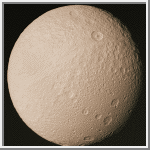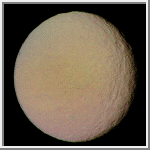















|
Tethys [TEE-this] was discovered by Giovanni Cassini in 1684. It is an icy body similar in nature to Dione and Rhea. The density of Tethys is 1.21 gm/cm3, indicating that it is composed almost entirely of water-ice. Tethys's icy surface is heavily cratered and contains cracks caused by faults in the ice. There is one enormous trench on Tethys about 65 kilometers (40 miles) wide and extending from above the center to the extreme left. It covers three-fourths of Tethys' circumference. The fissure is about the size scientists would predict if Tethys were once fluid and its crust hardened before the interior. The canyon has been named Ithaca Chasma. A vast expanse of relative young plains also exists on Tethys. Tethys' surface temperature is -187° C (-305° F).
| Animation of Tethys |
|---|
| Views of Tethys |
|---|
 Tethys
Tethys
This view of Tethys was taken by Voyager 2 on August 26, 1981.
It is the highest resolution image acquired by the Voyager
spacecraft. An enormous trench named Ithaca Chasma
extends from the left side of this image to the upper center.
(Credit: Calvin J. Hamilton)
 Tethys Color Composite
Tethys Color Composite
This view of Tethys is a color composite of three images
taken by Voyager 2 on August 25, 1981.
(Credit: Calvin J. Hamilton)

 Saturn
Saturn
 Enceladus
Enceladus
 Telesto & Calypso
Telesto & Calypso

Copyright © 1997 by Calvin J. Hamilton. All rights reserved.